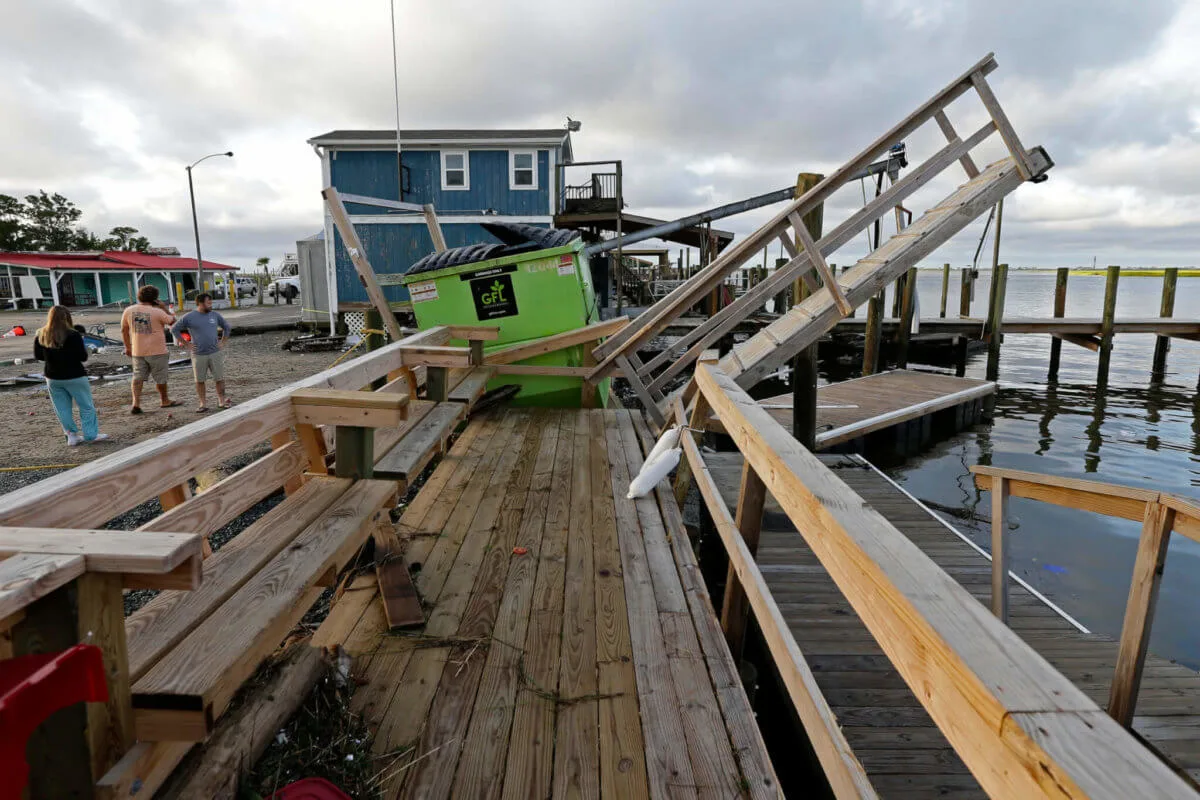
A waterfront dock shows damage following the effects of Hurricane Isaias in Southport, N.C., Tuesday, Aug. 4, 2020. The 2021 hurricane season is off to a fast start. Here are some tips to prepare for any storms ahead. (AP Photo/Gerry Broome)
Officials say danger at the Southport plant was minimal, but advocates warn hurricanes pose a major risk for nuclear facilities.
A North Carolina nuclear plant in the path of Tropical Storm Isaias reported an “unusual” loss of power Tuesday morning, Fox Business reported.
When Isaias made landfall as a hurricane at 11 pm Monday night near Ocean Isle Beach, the storm spawned tornadoes, flooding and fires, as well as widespread power outages in the region.
But near the North and South Carolina state line, the hurricane also took out a major power line providing electricity to the Brunswick Nuclear Plant near Southport, plant spokesperson Karen Williams, told WWAY.
When the offsite power loss triggered the plant’s safety systems early Tuesday morning, one of the coastal plant’s two reactors was shut down as a precaution. According to an update from Duke Energy personnel, the plant’s second reactor was not affected.
As an additional precaution, nuclear plant operators are authorized to shut down their facilities depending on wind speeds, reported financial news site S&P Global.
‘Minimal’ Risk?
According to the US Nuclear Regulatory Commission (NRC), the loss of offsite power is “an important contributor to total risk at nuclear power plants.”
But Williams minimized any possible danger, saying the Brunswick facility followed robust procedures to bring the reactor back online. Electricity to customers was not impacted, she offered, because the plant was able to direct power to the grid from other sources.
Brunswick is one of 11 nuclear reactors that Duke Energy operates at six sites in North and South Carolina. Together, the facilities generate about 10,700 megawatts, according to the company’s website. Duke Energy states that their nuclear plants generate about half of the electricity for their customers, servicing 4.2 million people in the Carolinas.
Two of the company’s North Carolina plants, Brunswick and the Shearon Harris Nuclear Power Plant in Wake County, lay in the path of Isaias, which was downgraded to a tropical storm after landfall.
Dominion Energy’s Surry plant in Surry County, Va., was also in the storm’s path. Dominion Energy Virginia and affiliate Dominion Energy South Carolina Inc. serve more than 3.3 million electric customers in Virginia, North Carolina and South Carolina.
According to PowerOutage.US, more than 500,000 homes and businesses lost electricity, most of them in North Carolina and Virginia.
An update posted on the US NRC website described the Brunswick incident as an “unusual event due to a loss of offsite power.” An unusual event is the lowest threat level designation mandated by the commission.
“There was no impact to the health and safety of the public or plant personnel,” the NRC update stressed. “The safety significance of the event is minimal.”
Despite Brunswick operators’ assurances that “all safety related systems operated as designed,” the incident revived concerns about the risks of operating a nuclear power plant in the path of a hurricane.

A Wake-Up Call?
Last April, Kevin Kamps of the national anti-nuclear watchdog organization Beyond Nuclear, pointed to the hazards posed by the storage of radioactive fuel waste at nuclear power plants, particularly in the event of extreme weather conditions
In March 2011, a massive tsunami damaged emergency pumps meant to cool the reactors at the Fukushima Daiichi Nuclear Power Plant in Japan, Kamps noted to Carolina Public Press.
Evaporating water in at least one densely packed cooling pool caused ambient air to come in contact with the spent fuel, Kamps said. The result was a major meltdown plus subsequent explosions. More than 150,000 residents had to be evacuated amid fears of possible health risks from the leaked radiation.
When Hurricane Florence struck the Carolinas’ coast in the fall of 2018, the storm raised the specter of a disaster like Fukushima happening in North Carolina,
North Carolina’s Department of Health and Human Services told National Geographic that the Brunswick power plant was shut down when winds exceeded 70 mph as a cautionary procedure.
Since nuclear waste storage pools are vulnerable to extreme events such as hurricanes, Kamps said the best solution is to move spent fuel from wet storage facilities like Fukushima’s to dry storage facilities, which are safer.
But moving to dry storage is costly, and Kamps alleged that the power industry is motivated to move as little fuel as possible.
Kamps raised further safety concerns for nuclear plants due to COVID-19. If the pandemic spreads into the nuclear power workforce, he said, it could potentially disrupt security or other key safety systems.

Op-Ed: Studying the Holocaust remains vital to ensuring it never happens again
International Holocaust Day will be observed on January 27, 2024. This day commemorates the liberation of the Auschwitz concentration camp by the...

VIDEO: How Rural Broadband Is Coming to This North Carolina County
More than 1.1 million North Carolinians lack access to high-speed internet, a necessity of the modern economy. In Warren County, help is on the way,...

VIDEO: Sampson County puts Biden’s promise to boost rural infrastructure to the test
Locals in this rural NC county say their water and air is polluted by a PFAS-contaminated landfill, massive hog and poultry farms, and industrial...

VIDEO: Sampson County puts Biden’s promise to boost rural infrastructure to the test
Locals in this rural NC county say their water and air is polluted by a PFAS-contaminated landfill, massive hog and poultry farms, and industrial...

Mold and classes in trailers: Inadequate funding for schools is hurting NC communities
Schools across the state are dealing with dilapidated classrooms and buildings in need of significant repair or a total rebuild due to a lack of...







